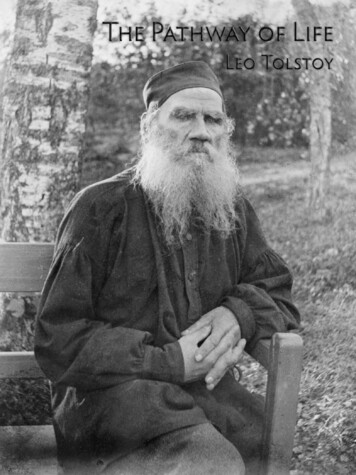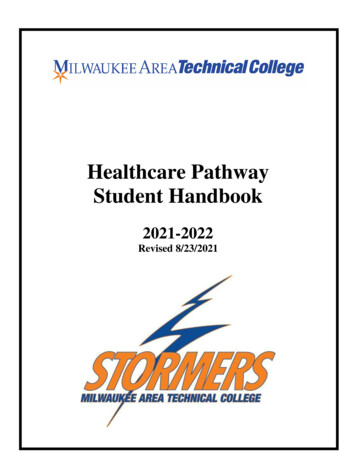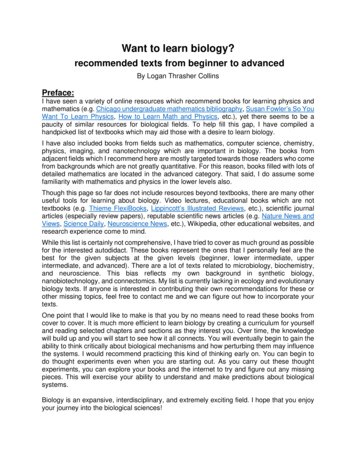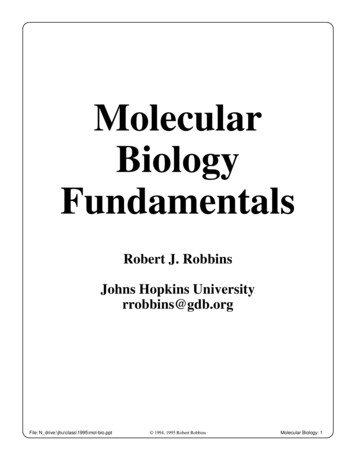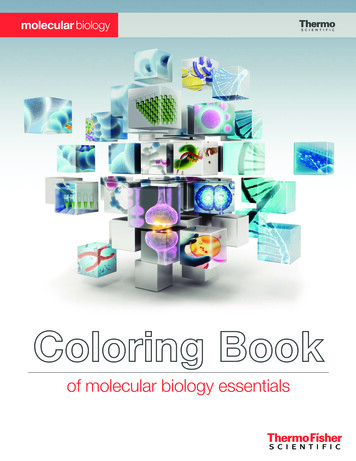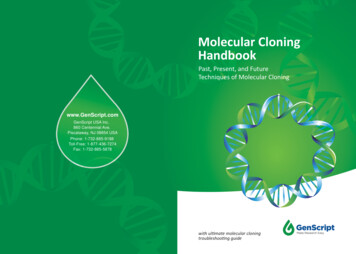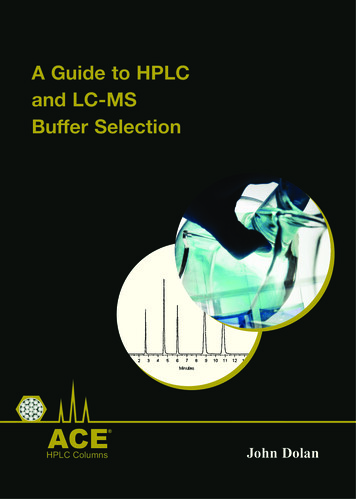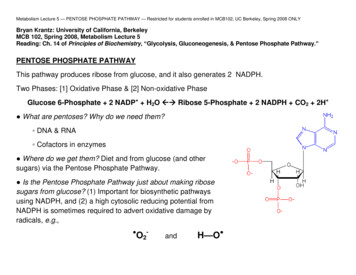
Transcription
Metabolism Lecture 5 — PENTOSE PHOSPHATE PATHWAY — Restricted for students enrolled in MCB102, UC Berkeley, Spring 2008 ONLYBryan Krantz: University of California, BerkeleyMCB 102, Spring 2008, Metabolism Lecture 5Reading: Ch. 14 of Principles of Biochemistry, “Glycolysis, Gluconeogenesis, & Pentose Phosphate Pathway.”PENTOSE PHOSPHATE PATHWAYThis pathway produces ribose from glucose, and it also generates 2 NADPH.Two Phases: [1] Oxidative Phase & [2] Non-oxidative PhaseGlucose 6-Phosphate 2 NADP H2O Ribose 5-Phosphate 2 NADPH CO2 2H What are pentoses? Why do we need them? DNA & RNA Cofactors in enzymes Where do we get them? Diet and from glucose (and othersugars) via the Pentose Phosphate Pathway. Is the Pentose Phosphate Pathway just about making ribosesugars from glucose? (1) Important for biosynthetic pathwaysusing NADPH, and (2) a high cytosolic reducing potential fromNADPH is sometimes required to advert oxidative damage byradicals, e.g., O2-andH—O
Metabolism Lecture 5 — PENTOSE PHOSPHATE PATHWAY — Restricted for students enrolled in MCB102, UC Berkeley, Spring 2008 ONLYTwo Phases of the Pentose Pathway
Metabolism Lecture 5 — PENTOSE PHOSPHATE PATHWAY — Restricted for students enrolled in MCB102, UC Berkeley, Spring 2008 ONLYNADPH vs. NADH
Metabolism Lecture 5 — PENTOSE PHOSPHATE PATHWAY — Restricted for students enrolled in MCB102, UC Berkeley, Spring 2008 ONLYOxidative Phase: Glucose-6-P Ribose-5-PGlucose 6-phosphate dehydrogenase. Firstenzymatic step in oxidative phase, converting NADP to NADPH.Glucose 6-phosphate NADP 6-Phosphoglucono-δ-lactone NADPH H Mechanism. Oxidation reaction of C1 position.Hydride transfer to the NADP , forming a lactone,which is an intra-molecular ester.Energetics. Very favorable reaction in the forwarddirection for producing NADPH.
Metabolism Lecture 5 — PENTOSE PHOSPHATE PATHWAY — Restricted for students enrolled in MCB102, UC Berkeley, Spring 2008 ONLYLactonase. A specific enzyme that targets 6Phosphoglucono-δ-lactone for hydrolysis.6-Phosphoglucono-δ-lactone 6-PhosphogluconateMechanism. The lactone is opened by hydrolysis, theaddition of water to cleave a bond, usually a type of amide orester. In this case, since the lactone (by definition) is intramolecular, then 6-phosphoglucono-δ-lactone is opened up tothe acid form, gluconate.Energetics. Often these types of hydrolysis reactions arevery favorable.
Metabolism Lecture 5 — PENTOSE PHOSPHATE PATHWAY — Restricted for students enrolled in MCB102, UC Berkeley, Spring 2008 ONLY6-Phosphogluconate dehydrogenase. Performs oxidative decarboxylation converting the 6-carbonskeleton to a pentose.6-Phosphogluconate NADP D-Ribulose 5-phosphate NADPH H CO2Mechanism. The C1 carboxylate is removed as the C3position is oxidized to a ketone, making 5-carbon ketose,ribulose.
Metabolism Lecture 5 — PENTOSE PHOSPHATE PATHWAY — Restricted for students enrolled in MCB102, UC Berkeley, Spring 2008 ONLYPhosphopentose Isomerase.D-Ribulose 5-phosphate D-Ribose 5-phosphateMechanism. Typical ketose to aldoseconversion. Another example of a general acidbase catalyzed reaction.
Metabolism Lecture 5 — PENTOSE PHOSPHATE PATHWAY — Restricted for students enrolled in MCB102, UC Berkeley, Spring 2008 ONLYNon-oxidative Phase: Recycling Pentose Phosphates to Glucose 6-PhosphateWhat if the cell needs much more NADPH than it needs pentose? D-ribose 5-phosphate has to beconverted back to glucose 6-phosphate in multiple enzyme catalyzed steps.The recycling of 5-carbon skeletons as expected for the stoichiometry below is complex:6 Pentose 5 Hexose
Metabolism Lecture 5 — PENTOSE PHOSPHATE PATHWAY — Restricted for students enrolled in MCB102, UC Berkeley, Spring 2008 ONLYRibulose 5-Phosphate Epimerase.Ribulose 5-phosphate Xylulose 5-phosphateMechanism. Epimerization reactionis the flipping of a stereo center in thesubstrate. An epimer of a compoundoccurs when only one stereo center isflipped.
Metabolism Lecture 5 — PENTOSE PHOSPHATE PATHWAY — Restricted for students enrolled in MCB102, UC Berkeley, Spring 2008 ONLYTransketolase & TransaldolaseA myriad of steps are required to transform pentoses back to glucose, but besides the epimerase,only two other new enzymes are needed: [1] transketolase and [2] transaldolase.Transketolase. This enzyme uses a cofactor,called thiamine pyrophosphate (TPP). TPP isused to stabilize a 2-carbon carbanion intermediate.Transaldolase. This enzyme forms a protonatedSchiff base intermediate with a ketose, stabilizing a3-carbon carbanion intermediate, allowing analdehyde based sugar to react with the enzymelinked ketose. The mechanism is similar to aldolase.
Metabolism Lecture 5 — PENTOSE PHOSPHATE PATHWAY — Restricted for students enrolled in MCB102, UC Berkeley, Spring 2008 ONLY[1] Transketolase TPPRibulose 5-phosphate Xylulose 5-phosphate Sedoheptulose 7-phosphate Glyceraldehyde 3-phosphate (G3P)[2] TransaldolaseSedoheptulose 7-phosphate Glyceraldehyde 3-phosphate (G3P) Fructose 6-phosphate Erythrose 4-phosphate[3] Transketolase TPPErythrose 4-phosphate Xylulose 5-phosphate Glyceraldehyde 3-phosphate (G3P) Fructose 6-phosphate[4] Reversal of GlycolysisG3P DHAP G3P Fructose 1,6-bisphosphate Fructose 6-phosphate
Metabolism Lecture 5 — PENTOSE PHOSPHATE PATHWAY — Restricted for students enrolled in MCB102, UC Berkeley, Spring 2008 ONLYReactions Required to Convert 6 Pentoses to 5 Hexoses
Metabolism Lecture 5 — PENTOSE PHOSPHATE PATHWAY — Restricted for students enrolled in MCB102, UC Berkeley, Spring 2008 ONLYProtection from Radical Damage
Metabolism Lecture 5 — PENTOSE PHOSPHATE PATHWAY — Restricted for students enrolled in MCB102, UC Berkeley, Spring 2008 ONLYRegulation of the Pentose Phosphate Pathway.How is this pentose phosphate pathway regulated? NADPH which is generated in the oxidativebranch of the pathway can feed back and inhibit the pathway. Glucose 6-phosphate can still beutilized by glycolysis.
Metabolism Lecture 5 — PENTOSE PHOSPHATE PATHWAY — Restricted for students enrolled in MCB102, UC Berkeley, Spring 2008 ONLY Oxidative Phase: Glucose-6-P Ribose-5-P Glucose 6-phosphate dehydrogenase. First enzymatic step in oxidative phase, converting NADP to NADPH. Glucose 6-phosphate NADP 6-Phosphoglucono-δ-lactone NADPH H


